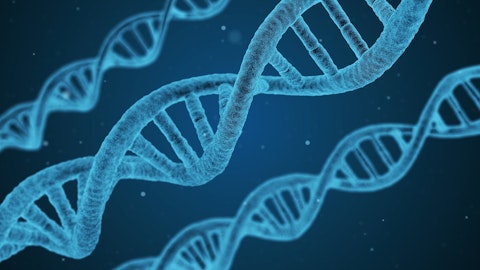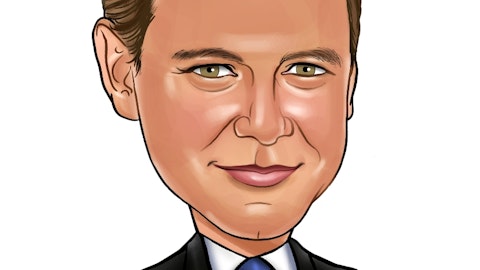These patients also have difficulty with sometimes tracking objects with their eyes. Most of them do have significant hand function abnormalities and stereotypic movements, and they also have difficulties with social interaction and many of them have cognitive challenges. So clinically, those are components that we have to focus on. And we did highlight that our gene therapy in both patient one and two did have impact on some of these aspects of the disease. We’ve also highlighted the impact on the autonomic dysfunction and then the scales that you refer to really the numbers on the scales and the degree of change on these scales actually depend on how severe the phenotype is. The more severe the phenotype, the higher the RSBQ and the RMB scores can be.
And then post-treatment, if the therapeutic is efficacious then you’ll see a relative change in the number and you will see that even in RSBQ for the second patient, the numbers are much lower because the patient overall has a much milder phenotype. So, you have to keep that relative aspect in mind and look at the broader clinical impact of the product because clinical transformation impact, I think, is far more important from a clinical management and regulatory review standpoint sometimes than a certain scales. And I’ll leave it at that for now.
Operator: The next question comes from Salveen Richter from Goldman Sachs.
Unidentified Analyst: This is Elizabeth on for sine. Congratulations on the data. I was hoping you could provide additional color on the seizure activity in the seizure diary. Specifically what was the baseline seizure rate for each patient prior to steroid treatment and what’s being observed now? And then also for the second patient, if you could provide some color on how quickly improvements were observed. I know for the first patient, those were observed quite soon after treatment. So any color there would be helpful.
Sean Nolan: Yes. So, that’s a very important question that you ask because, so I’m going to try and walk you through first patient and second patient because there are lots of clinical aspects to the seizure history in both patients. So patient one, stage four 20 year old female, right, with severe Rett syndrome had four to five seizures per quarter before the gene therapy was given. The first six weeks post gene therapy there were no reported seizures in the seizure diary nor in the EEG that was reviewed by the PI. After week six, what was noticed is, this patient is on prednisolone and sirolimus and sirolimus actually works on the liver and inhibits the cytochrome P450 system, which results in Dilantin levels dropping significantly.
So what happened after week six up to now is that the Dilantin levels dropped to below 50, which is very low, and therefore there was some breakthrough seizures in this patient. From what I recall, I think this patient had about seven seizures during the period following the six weeks post-treatment. Now, it is also of interest to note before the gene therapy was given, whenever this patient one had seizures, usually it was when the Dilantin levels were below 100, but I think usually above 50. So I would say that even though this patient had breakthrough seizures six weeks post-gene therapy, this happened when the Dilantin levels were below 50. And therefore, I think the gene therapy still had a protective effect, but the Dilantin levels got way too low to which allowed for breakthrough seizures.
So that is patient one, and the patient is doing well. Patient…
Sukumar Nagendran: Yes. So just to try to hit a punch line on that question, Elizabeth, I would say pre and post treatment through week 20 the seizure rates are comparable. His pre-treatment, the patient generally experienced seizures if she had dilantin levels below a 100. And now what it is looking like post-treatment is that the seizures occur when she’s less than 50 so at a much lower amount of Dilantin.
Sukumar Nagendran: Yes. Thank you, Sean, for clarifying that. And then patient two had roughly four seizures per month, which is 12 seizures, I guess every quarter. Following gene therapy treatment with our product, this patient had one breakthrough seizure up to week six, if I recall on day 13th. But that was it, just one seizure. So, that is a good signal that our gene therapy is most likely having impact on seizure incidence in this patient as well. So, that’s the update on the seizure question for you. Thank you.
Unidentified Analyst: Super helpful. And then just on the second question of the rapidity of response observed in the second patient.
Sukumar Nagendran: Yes. So, that’s another important question. So just again to go back to the technology, jour product has a self-complimentary DNA. So once it’s given into the central CSF and gets into the central nervous system, the episode is formed within 48 hours and we think starts producing the MECP1 protein. And the principal investigator has noted that clinical impact appears to be noted within seven to 10 days initially post the gene therapy being given via lumbar puncture. And this includes impact on some motor function as well as reducing some of the autonomic abnormalities. So we are pleased to see that and we hope that will continue because that will hopefully give some of these patients rapid relief of their serious symptomology.
Operator: Thank you. The next question comes from Gil Blum from Needham & Co. Please proceed with your question.
Gil Blum: Allow me to have my congratulations. It’s actually rather impressive. So one thing I do want to understand about some of these metrics, could there be a ceiling effect, I mean, specifically talking about RSBQ, we’re kind of seeing a leveling around 30. I’m not super familiar with the scale, but is that a possibility?
Sean Nolan: A ceiling effect?
Sukumar Nagendran: Yes, sorry, go ahead, Sean.
Sean Nolan: Well, what I would say to that, Gil, is a non-clinician would be — I think we have to take into account the stage of the disease, the age of the patients and the dose that we’re in at this particular point in time in the study all have to be considered into whether or not there’s a ceiling being demonstrated. We are right now landing in some similar spots to your point, and it’s still a little early in the assessment, but with that, I’ll defer to Suku on the clinical question.
Sukumar Nagendran: No, that’s an important question that I think we are still struggling to assess, because keep in mind that both these patients were adults, right? So they were 20 and 21 year old females where we frankly did not expect to see much effect. And the most severe the patient, the higher, I assume the RSBQ score should be given that there are 45 items in that scale, and 38 of them are used to maximize the score of to up to a 90. And also keep in mind the — it is very important to understand who actually does the assessment. It’s usually done by the parents or the caregivers over a period of time. So they have to reflect on how the patient or their child or is doing over a course of a week or so. So there can be some variability in the score being assessed as well.
And then finally, as far as there being a ceiling effect, I think what we are observing with the gene therapy is the more sicker the patient, the higher the score and the greater the drop. While the patient is not as sick, the drop may not be as significant because they’re starting at a much lower baseline. I think I can probably answer your question once you dose a few more patients and we have a little more data. And then the other thing to keep in mind with RSBQ is that the questions you have to actually look at the questions being asked because some of the questions have been designed to evaluate the disease process that worsens over time. RSBQ frankly was not developed to evaluate the therapeutic intervention. Now, the caveat is for phenotype did use RSBQ combined with CGI-I for a combined endpoint to get their approval.




